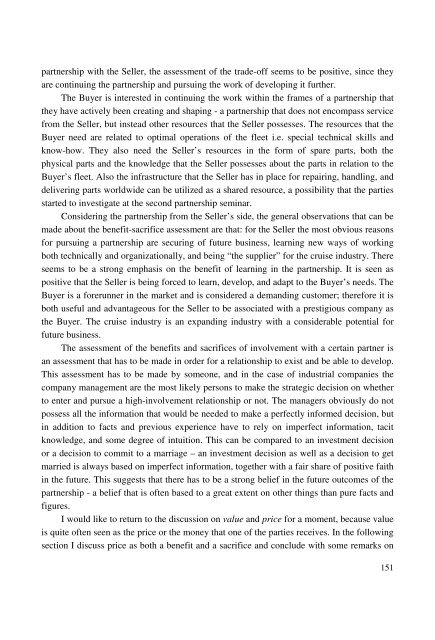Value Co-Creation in Industrial Buyer-Seller Partnerships ... - Doria
Value Co-Creation in Industrial Buyer-Seller Partnerships ... - Doria
Value Co-Creation in Industrial Buyer-Seller Partnerships ... - Doria
- No tags were found...
You also want an ePaper? Increase the reach of your titles
YUMPU automatically turns print PDFs into web optimized ePapers that Google loves.
partnership with the <strong>Seller</strong>, the assessment of the trade-off seems to be positive, s<strong>in</strong>ce theyare cont<strong>in</strong>u<strong>in</strong>g the partnership and pursu<strong>in</strong>g the work of develop<strong>in</strong>g it further.The <strong>Buyer</strong> is <strong>in</strong>terested <strong>in</strong> cont<strong>in</strong>u<strong>in</strong>g the work with<strong>in</strong> the frames of a partnership thatthey have actively been creat<strong>in</strong>g and shap<strong>in</strong>g - a partnership that does not encompass servicefrom the <strong>Seller</strong>, but <strong>in</strong>stead other resources that the <strong>Seller</strong> possesses. The resources that the<strong>Buyer</strong> need are related to optimal operations of the fleet i.e. special technical skills andknow-how. They also need the <strong>Seller</strong>’ s resources <strong>in</strong> the form of spare parts, both thephysical parts and the knowledge that the <strong>Seller</strong> possesses about the parts <strong>in</strong> relation to the<strong>Buyer</strong>’ s fleet. Also the <strong>in</strong>frastructure that the <strong>Seller</strong> has <strong>in</strong> place for repair<strong>in</strong>g, handl<strong>in</strong>g, anddeliver<strong>in</strong>g parts worldwide can be utilized as a shared resource, a possibility that the partiesstarted to <strong>in</strong>vestigate at the second partnership sem<strong>in</strong>ar.<strong>Co</strong>nsider<strong>in</strong>g the partnership from the <strong>Seller</strong>’ s side, the general observations that can bemade about the benefit-sacrifice assessment are that: for the <strong>Seller</strong> the most obvious reasonsfor pursu<strong>in</strong>g a partnership are secur<strong>in</strong>g of future bus<strong>in</strong>ess, learn<strong>in</strong>g new ways of work<strong>in</strong>gboth technically and organizationally, and be<strong>in</strong>g “ the supplier” for the cruise <strong>in</strong>dustry. Thereseems to be a strong emphasis on the benefit of learn<strong>in</strong>g <strong>in</strong> the partnership. It is seen aspositive that the <strong>Seller</strong> is be<strong>in</strong>g forced to learn, develop, and adapt to the <strong>Buyer</strong>’ s needs. The<strong>Buyer</strong> is a forerunner <strong>in</strong> the market and is considered a demand<strong>in</strong>g customer; therefore it isboth useful and advantageous for the <strong>Seller</strong> to be associated with a prestigious company asthe <strong>Buyer</strong>. The cruise <strong>in</strong>dustry is an expand<strong>in</strong>g <strong>in</strong>dustry with a considerable potential forfuture bus<strong>in</strong>ess.The assessment of the benefits and sacrifices of <strong>in</strong>volvement with a certa<strong>in</strong> partner isan assessment that has to be made <strong>in</strong> order for a relationship to exist and be able to develop.This assessment has to be made by someone, and <strong>in</strong> the case of <strong>in</strong>dustrial companies thecompany management are the most likely persons to make the strategic decision on whetherto enter and pursue a high-<strong>in</strong>volvement relationship or not. The managers obviously do notpossess all the <strong>in</strong>formation that would be needed to make a perfectly <strong>in</strong>formed decision, but<strong>in</strong> addition to facts and previous experience have to rely on imperfect <strong>in</strong>formation, tacitknowledge, and some degree of <strong>in</strong>tuition. This can be compared to an <strong>in</strong>vestment decisionor a decision to commit to a marriage – an <strong>in</strong>vestment decision as well as a decision to getmarried is always based on imperfect <strong>in</strong>formation, together with a fair share of positive faith<strong>in</strong> the future. This suggests that there has to be a strong belief <strong>in</strong> the future outcomes of thepartnership - a belief that is often based to a great extent on other th<strong>in</strong>gs than pure facts andfigures.I would like to return to the discussion on value and price for a moment, because valueis quite often seen as the price or the money that one of the parties receives. In the follow<strong>in</strong>gsection I discuss price as both a benefit and a sacrifice and conclude with some remarks on151
















